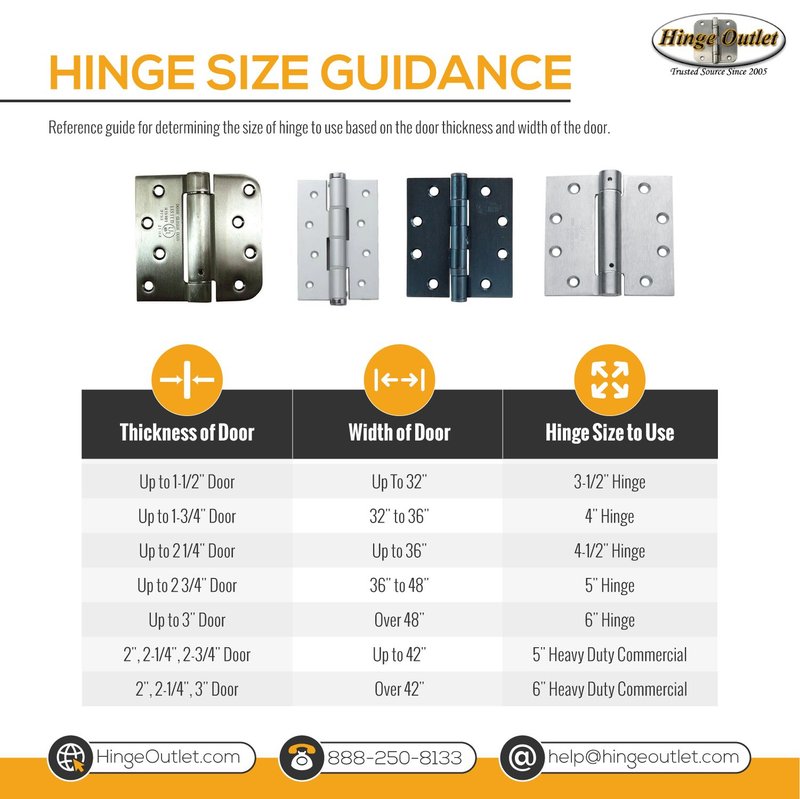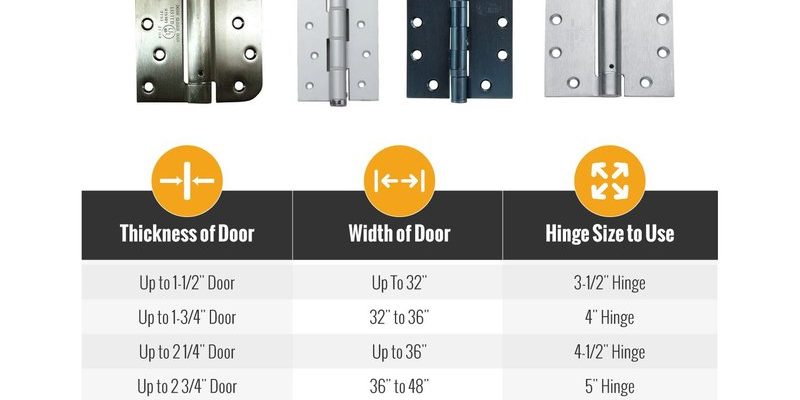
So, how do you find the right hinge size for your interior door? It’s easier than it seems! Imagine you’re in a hardware store, trying to figure out which of the many options will fit your specific needs. Don’t worry—I’m here to guide you through it, step by step. Whether you’re replacing old hinges or installing a new door, understanding hinge sizes will help you get the job done right.
Understanding Hinge Sizes
When it comes to hinges, size matters! The hinge size refers to its dimensions, typically defined by the width and the length of the leaf (the flat parts that attach to the door and the door frame). Most interior door hinges come in standard sizes, often 3 to 4 inches wide. But what does this mean for your door?
To put it simply, the size of the hinge affects how well it supports the door’s weight and how smoothly it operates. A hinge too small may not hold the door securely, while one that’s too large can look out of place. So, how do you determine the right size?
Key factors to consider:
– Door weight: Heavier doors need sturdier hinges.
– Door thickness: Thicker doors require hinges with a longer leaf to fit properly.
– Usage frequency: High-traffic doors need durable hinges to withstand wear and tear.
Here’s the thing: measuring for hinges is straightforward. Just grab a tape measure and take note of the width, length, and thickness of your door. You’ll want to ensure that the hinge you choose matches these dimensions for optimal performance.
Measuring Your Door and Current Hinges
Before heading to the store, it’s time to do a little reconnaissance. Start by measuring both the current hinges and the door itself. If you’re replacing old hinges, this step is especially important.
1. Measure the Current Hinge:
– Remove the hinge from the door if possible.
– Measure the width and height of the hinge leaf.
– Also, note the thickness of the hinge pin.
2. Measure the Door:
– Measure the door’s height, width, and thickness using a tape measure.
– This will help you determine the best hinge size to support the overall weight.
Make sure to jot down all your measurements. You might even want to take a photo of the current hinges to show when you’re shopping.
Here’s a little tip: If your door is a non-standard size, you might consider custom hinges. While this may be a more expensive option, it will ensure a perfect fit.
Choosing the Right Material for Your Hinges
Now that you know the size of your hinges, let’s talk about materials. Door hinges come in a variety of materials, each offering its own benefits. Here are some common types:
- Steel: Very durable and perfect for heavy doors. They resist warping and bending.
- Brass: Offers a stylish look and good strength, but can be more expensive.
- Stainless Steel: Great for moisture-prone areas, as they resist rust and corrosion.
- Plastic: Best for lightweight doors or temporary solutions, as they may not last long under heavy usage.
When selecting the material, consider where the door is located. Is it a bathroom door that might see moisture? Or is it a high-traffic door that opens often? A sturdy material like stainless steel would be ideal in that case.
Different Types of Hinges
Not all hinges are created equal, and the type of hinge you choose can impact the door’s functionality. Here are a few common types of hinges for interior doors:
– Butt Hinges: The most common type found on residential doors. They consist of two leaves that fit together.
– Continuous Hinges: Also known as piano hinges, these run the full length of the door. They provide extra support and are ideal for heavy doors.
– Spring Hinges: These automatically close a door after it’s opened. They’re great for doors that need to stay closed, such as in a bathroom.
– Concealed Hinges: Hidden from view when the door is closed, these offer a sleek look and are common in cabinetry.
Choosing the right type of hinge can enhance not just the functionality of your door but also its visual appeal.
Installing New Hinges
Once you’ve selected the size and type of hinge, it’s time for the installation. If you’re replacing old hinges, this can be a simple task. Here’s a step-by-step guide to help you with the process:
1. Remove the Old Hinges: Start by unscrewing the old hinges from the door and the frame.
2. Position the New Hinges: Align them the same way as the old ones. The top hinge should be about 7 inches from the top of the door, and the bottom hinge should be around 11 inches from the bottom.
3. Secure the Hinges: Use an electric screwdriver or a manual screwdriver to attach the hinges, making sure they’re snug but not overly tight.
4. Test the Door: After both hinges are installed, open and close the door to check for smooth operation. If it sticks, you may need to adjust the hinge position slightly.
And voila! You’ve successfully installed new hinges. It’s amazing how something so small can make such a big difference in a door’s functionality.
Common Problems and How to Fix Them
Even with the right hinge size and installation, you might encounter a few common issues. Here are some problems and how to troubleshoot them:
– Squeaky Hinges: A common nuisance! Apply a few drops of lubricant like WD-40 or silicone spray. Open and close the door a few times to work it in.
– Doors Sticking: If your door is sticking, it might mean the hinge isn’t aligned correctly. Loosen the screws slightly, adjust the hinge, and retighten.
– Loose Hinges: If the screws are coming loose, consider using larger screws or adding wood filler to give them something to grip onto.
Being able to identify and fix these problems can save you time and frustration down the road.
Finding the right hinge size for your interior door might feel daunting at first, but it can be a fun DIY project! By measuring correctly, selecting the right material and type, and installing with care, you’re setting yourself up for a hassle-free door experience.
As you dive into this task, remember that the right hinges not only support the door but also enhance its overall appearance. You’ve got this! Whether you’re a beginner or just looking for a quick refresher, knowing how to identify the proper hinge size helps you feel more confident as a homeowner. Now, get out there and give your doors the attention they deserve!
